
Cadmus: The Amazing Tale of the First Greek Hero and It’s Horrible End
Out of all the pantheons, the exuberant deities of the ancient Greeks are perhaps the most iconic of all. For generations, imaginations have been enflamed and inspired by the sumptuous mix of high fantasy and human imperfection the gods of Olympus present, as they cheat, deceive, and contrive in the name of their own personal ambitions and animosities. One of these larger-than-life characters is Cadmus, a lesser well-known but equally fascinating character of the divine drama, and Greece’s first mythical hero. The story of Cadmus starts triumphantly, before plunging into the deepest of sorrows.
Cadmus, Fifth Generation Olympian: Family and Genealogy
Cadmus, considered the first Greek hero, was a fifth-generation god of the Olympian bloodline started by Zeus and Io. Io, the daughter of the river god of Argos, Inachos, pledged herself to Zeus after fleeing from her father’s domain in the form of a cow and ending up at the River Nile. It was there that she met Zeus, producing for him a son called Epaphos, who would be a great grandfather to Cadmus.
- Pythia: Oracle and High Priestess of Delphi
- Five Female Olympians of Ancient Greece: The Good, the Bad and the Ugly
Cadmus is the great-great grandson of Zeus, the grandson of Poseidon, and the son of Agenor, and the goddess Telephassa. He has three brothers called Phoenix, Cilix, and Thasus, and one sister, Europa. Cadmus also boasts Ares and Aphrodite as his parents-in-law through his marriage to Harmonia. Cadmus is the grandfather of Dionysus and the father of his mother, Semele. His other daughters were Ino, Agave and Autonoe, and his sons were Polydorus and Illyrius.

Cadmus asks the Oracle at Delphi where he can find his lost sister Europa in a drawing by Hendrik Goltzius. (Los Angeles County Museum of Art / Public domain)
Cadmus and His Quest to Find His Sister, Europa
The myth of Cadmus starts with the search for his sister, Europa. One day Europa was playing by a field near the sea, making flower wreaths for her older brothers Cadmus, Cilix, and Thasus. Zeus, spotting her from afar, noted her charm, and approached her as a white bull with glistening silver horns. Spellbound by the appearance of the majestic creature, Europa, initially scared, fed him some clover blossoms, and the bull started to dance and skip around, assuaging her fears. She got onto its back, and started to ride it around, holding onto its horns with glee.
When Europa realized the bull was galloping away from her brothers, she let out a massive scream. Her brothers heard, but the bull, too fast for them, got away and Europa was never seen again. She would go on to become the matriarch of the Greek kings of Crete.
When the brothers told their father, King Agenor, what had happened, he scolded them for leaving their sister unsupervised. Because Cadmus was the eldest brother, Agenor blamed him most. He ordered Cadmus to retrieve his sister. If he did not find her, he was never to enter the confines of his father’s kingdom ever again. Cadmus’ search took him to vast forests, desolate mountains, and across the sea to foreign lands, but no matter where he looked he couldn’t find any trace of his sister Europa.
Cadmus knew he couldn’t return to his father, and so he asked the Oracle at the shrine of Apollo, a prophetic voice that echoed from the deep caves at the foot of Mount Parnassus, what he should do next. The Oracle advised him to follow a white cow, and to begin the construction of a great city wherever it lay down.
Immediately upon leaving the mountain temple, Cadmus saw the white cow, and proceeded to follow its path. The cow settled down in the middle of an ancient forest. Cadmus explored a nearby cave, in which he found two bright points of light. They were in fact the eyes of a fearsome dragon. Once Cadmus realized this, he threw a large stone at the monster, which bounced ineffectively off its tough scales. His next move was to throw a spear at the raging beast. The dragon suffered only minor injuries, and began to advance quickly towards Cadmus, hissing with fury.
When it was sufficiently near, Cadmus took the spear and thrust it through the dragon’s open mouth, pinning it to the trunk of a nearby tree. Although Cadmus was victorious, he was now faced with the mammoth task of founding a city in an area he knew nothing about.
Suddenly, a woman with gray eyes appeared next to him armed with a spear in her hand, wearing a helmet. It was Athena, the Greek war goddess, who instructed him to plow the ground around the forest and to plant the dragon’s teeth underneath. Shortly after, blades of steel began to poke up from the tilled earth. They were the swords of a battalion of soldiers, who emerged fully armored and immediately started to kill one another. The wisest five of these military men, Echion, Udaeus, Chthonius, Hyperenor, and Pelorus, known as the Spartoi, refused to fight, seeing no advantage in the bloodshed around them. They shook hands with each other, and then Cadmus, and commenced the construction of the great city of Thebes in Greece.

Polynices offering Eriphyle the cursed necklace of Harmonia, which slowly destroyed Cadmus and his family, on a classical Greek vase in the Louvre Museum collection. (Louvre Museum / Public domain)
Cadmus, Harmonia, and the Cursed Necklace of Hephaestus
As Cadmus built Thebes, however, he was faced with the repercussions of slaying the dragon. The beast had belonged to Ares, the Greek God of War, and had been guarding one of his sacred springs. Ares was furious, and demanded Cadmus give him eight years penance for his sin. Cadmus performed admirably for Ares, who rewarded him by offering his daughter’s hand in marriage.
The wedding of Cadmus and his new spouse Harmonia, who was the goddess of harmony, was an extravagant affair that took place on the Greek island of Samothrace. It was attended by many gods and goddesses and accompanied by the heavenly music of the Muses. Cadmus was granted the honor of dining at the same table as Zeus. A boar and a lion pulled the wedding carriage, which was accompanied by Apollo himself.
Alongside a fancy cloak, called a peplos, Harmonia received a necklace forged by Hephaestus, god of smiths, which granted her eternal youth. According to legend, it was constructed out of gold, jewels, and two snakes, whose mouths formed the clasp. But the amulet was cursed. It contained Hephaestus’ anger at discovering his wife Aphrodite was having an affair with Ares. When he crafted the talisman, Hephaestus made sure that misfortune would befall anyone who wore it. The union of Cadmus and Harmonia was jinxed from the very start, and grief would eventually envelop their family as a result.
The Misfortunes of the House of Cadmus
Cadmus and Harmonia’s daughter, Semele, princess of Thebes, was the first tragedy in the downfall of the Cadmus clan. Like Europa, Zeus took a liking to her after spying her from a distance while she was sacrificing a bull on an altar. Zeus, who was married to Hera, won Semele’s good graces, beginning an illicit affair from which Dionysius, the god of madness, was conceived. Hera, incensed at Zeus’ infidelity, set out to crush Semele. First she appeared to her in an unrecognizable form to start a friendship. When Semele told her new confidant about her fling with Zeus, Hera used her magic powers to make Semele doubt what she believed.
- Thebes, A City Formed by The Warriors Who Sprang from a Dragon’s Teeth
- Hermes: Messenger of the Gods and Patron of Traders, Travelers, and Thieves
Searching for confirmation, Semele set about summoning Zeus, requesting him to appear to her in all his glory. Zeus had previously made an oath to Semele granting her any wish she desired. Unfortunately, Semele herself was mortal, meaning that when Zeus came to her in “all his splendor” this included his lightning bolts, and she burst into flames, for humans were immediately obliterated when they laid their eyes on him. Zeus saved their unborn child, Dionysius, from annihilation by sewing him inside his thigh. Dionysius would later bring his mother back from the underworld, where she would be transformed into the goddess Thyone.
The next to experience ill-fortune was Ino, another daughter of Cadmus. She was the second wife of King Athamas and stepmother to Phrixus and Helle, whose mother was the cloud nymph Nebele. Although Athamas was the one to leave Nebele, Ino was incredibly jealous of her and resented her two children, especially after she gave birth to her own sons Learches and Melicertes. Keen to establish her own progeny as successors to King Athamas’ realm of Orchomenus, Ino plotted to remove Phrixus, who was the eldest and first in line.

A 4th-5th-century AD mosaic fragment of Ino discovered in a Roman villa in Saint-Rustice in 1833, which is now part of the Saint-Raymond Museum collection. (Carole Raddato / CC BY-SA 2.0)
She first bribed the farmers to ruin the harvest, causing a devastating famine. Athamas, seeking guidance, sent a herald to the Oracle for advice. Ino corrupted the herald, who reported back to Athamas that the famine could only end if Phrixus was ritually killed and offered to Zeus.
Alongside his brother Helle, Nebele sent a golden ram to rescue her sons, who escaped persecution to a faraway land. Although Phrixus hadn’t been killed as hoped for, he was out of the picture, paving the way for her own son Learches to take command.
At the same time, Zeus came to Ino with the infant Dionysius, and asked her to take care of her nephew after the demise of Semele. In order to hide him from Hera, Dionysus was disguised as a girl and raised in the house of Orchomenus. Hera quickly found out and employed the help of the mad-spirit Tisiphone to make Athamas go insane.
Athamas killed his son and heir Learches with an arrow bolt during a hunting trip, convinced he was a deer. Next, he mistook Ino for a lioness. With her baby son Melicertes cradled in her arms she fled from her deranged husband and plummeted to her death after falling off a cliff into the sea. Luckily Dionysus, shapeshifting into a goat, evaded detection, and escaped Hera’s vengeance.
Although punctuated with grief, Cadmus’ reign over Thebes was a prosperous one. As an older man Cadmus entrusted the rule of Thebes to his favorite grandson, Pentheus, who would become the next victim of the Hephaestus necklace curse. He was the son of Cadmus’ daughter, Agave, who had married Echion, one of the five Spartoi who was born from the dragon’s teeth. Pentheus deeply disliked his cousin, Dionysius, and banned his cult from the city of Thebes. Dionysius hatched an evil revenge plan of and lured Pentheus into the woods after promising he would see women performing sexual activities.
Dionysius led his cousin to a group of his acolytes, the Maenads, one of which was his own mother, Agave, and another his aunt Autonoe. Under Dionysus’ spell of madness, the sisters tore Pentheus apart in a murderous rage, and Agave was tricked into thinking that they had just killed a lion. She brought the head back to Thebes, only realizing it belonged to her own son after being reprimanded by Cadmus. Later on, the same fate would befall the son of Autonoe, Acataeon, a capable hunter who one day spied Artemis naked in the woods. As punishment, he was ripped to pieces by his own hounds.

Cadmus and Harmonia in the woods around Illyria fall to the evil of the necklace of Hephaestus and are turned into serpents. (Rijksmuseum / CC0)
The Illyrian Epilogue
Cadmus, heartbroken at the deaths of three of his daughters and two cherished grandsons, decided to leave Greece, traveling with his wife Harmonia to the frontiers in a carriage drawn by calves, where he entered the land of the Encheleans, in modern-day Albania. The Encheleans were fighting the Illyrians at the time and were told in a prophecy by the Oracle that only by making Cadmus their king could they win the war. Cadmus led the Encheleans to triumph and united their realm with the defeated Illyria. Afterwards, Cadmus’ last son, Illyrius, was born, and it was his name that became Illyria.
- Battle of the Gods, When Titans Took on Zeus
- Journeys to the Underworld – From Ancient Greece to Hollywood
It was around this time however that the necklace of Hephaestus would dispatch its last casualties, Cadmus and Harmonia themselves. By the time they had reached Illyria, both deities had been transformed into serpents. Legend even tells that Illyrius was cradled in the coils of snakes, making him strong.
Cadmus and Harmonia’s suffering finally ended in death. They were granted passage into Elysium, the heavenly paradise of the Greeks. Despite its brief glimmers of hope, the myth of Cadmus will always remain one of the most heart wrenching tragedies of the Olympians.
Top image: Cadmus, the first Greek hero and founder of Thebes, fighting the dreaded dragon in a painting by Hendrick Goltzius. Source: Hendrik Goltzius / Public domain
By Jake Leigh-Howarth
References
Davenport, C. Story: Cadmus and Europa. PB Press Books. Available at: https://iagtm.pressbooks.com/chapter/story-cadmus-and-europa/ .
Greek Legends and Myths. n.d. Ino in Greek Mythology. Available at: https://www.greeklegendsandmyths.com/ino.html .
Greek Mythology. 2015. Semele. Available at: https://www.greekmythology.com/Myths/The_Myths/Zeus's_Lovers/Semele/semele.html .
Howitt-Marshall, D. 2021. Who’s Who in Greek Mythology: C for Cadmus. Available at: https://www.greece-is.com/whos-greek-mythology-c-cadmus/ .
Kapach, A. 2022. Cadmus. Available at: https://mythopedia.com/topics/cadmus .
Kerenyi, K. 1959. The Heroes of the Greeks. Thames and Hudson.
Rohit. 2016. Agave. Greek Mythology. Available at: http://01greekmythology.blogspot.com/2016/08/agave.html .
















Comments
Reads like a dime store novel. Probably just theater of the times.
Nobody gets paid to tell the truth.